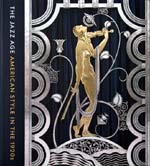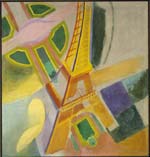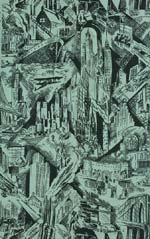
|

|
|
Home Site Search Contact Us Subscribe
|
|
Time for Jazzing Up Architectural Imagination? A monumental catalogue of a great exhibition architects need more than they may know - hurry to Cleveland if you missed it in Manhattan. Explore "The Jazz Age: American Style in the 1920s." By Norman Weinstein December 14, 2017 Here are two preposterous claims. You’ll know if you’ll care to read further after considering them:
1. The most inspirational new book architects need to read has a dozen pages dedicated wholly to architecture, the remaining 360 showcase largely decorative arts, with a dash of jazz in America during the Twenties. 2. The 1920s never stopped – in architecture – and much else culturally.
If you missed seeing “The Jazz Age: American Style in the 1920s” at the Cooper Hewitt, Smithsonian Design Museum earlier this year, you still have the opportunity to catch it at The Cleveland Museum of Art. Assuming visiting Cleveland in winter doesn’t fit your priorities, Yale University Press published the catalogue, by Sarah D. Coffin and Stephen Harrison, with contributions by Emily M. Orr, that is well worth your purchase. Here’s what the book distills from the exhibition. I’ll quote from the Cooper Hewitt press release:
“The first major exhibition to focus on American taste during the creative explosion of the 1920s. ‘The Jazz Age’ is a multi-media experience of more than 400 examples of interior design, industrial design, decorative art, jewelry, fashion, and architecture, as well as related music and film.”
Note that architecture is nearly the last temptation at the smorgasbord. But don’t trust the perfectly mediocre PR chatter. Here is how the PR text could have been written with accuracy in mind:
This major museum exhibition focuses upon what happened to American cultural sensitivities and sensibilities during the 1920s – “the Jazz Age.”
There is a monumental difference between “taste” and “sensibility.” “Sensibility” is a broader and deeper term that takes into account an architect’s awareness of client, site, materials, architectural traditions, and larger environmental contexts. “Taste” is more about an architect’s private proclivities. Richard R. Stadelman, architect for the Flamingo Las Vegas Hotel (arguably crude “Jazz Age” Art Deco completed in – surprise – 1946!) seemed to have an eye for hyper-vulgar Hollywood film sets. His taste for that dreck could help him relate to his client, mobster Bugsy Siegel. On the other hand, we talk about the “prairie sensibility” of Frank Lloyd Wright, which doesn’t translate into “Wright had a taste for prairie.”
Back to what architects can still learn from this jazz age exhibition and catalogue. Jazz might be characterized as a persistent sensibility-altering art form throughout American life. Whether or not you personally enjoy listening to jazz isn’t the point. What is the point is that in any period of American life when this culture becomes particularly “jazzy,” the following factors loom large:
· Assaults on the artistic “Good Taste” of previous generations. · Familiar artistic forms are broken down, then artfully reconstructed. · Old artistic rules once thought unchangeable rules become flexibly bent procedures. · The world keeps getting smaller at an accelerated pace. · Abstract forms facilitate new outpourings of imaginative artistic experimentation. · Machine technology is viewed as friend, not foe, by the creative artist.
These six factors are the organizing principles for “The Jazz Age” exhibition. Imagine if someone wrote a history of American architecture totally in synch with these categories. Let me add some connections between jazz as music during the “Jazz Age” (which I’m claiming as an ongoing enterprise) and architecture:
· Jazz is always about a revolution in perceiving rhythms. Couldn’t revolutions in architectural design also be reflective of large-scale cultural rhythm shifts? · At the heart of jazz performance to greater or lesser degree is improvisation. Can there be a viable client-architect relationship that isn’t improvised? · Jazz is an artistic form only actualized through constant dialogue between those upholding the beauty of traditional forms and those seeking new forms declaring beauty. Is architecture any different that jazz in that regard?
Of the many splendid images of decorative art lacing this exhibit, my favorites include architect IB Andersen’s, poster with cut-away view of an imagined Bauhaus-tinged Copenhagen house; Robert Delauney’s “Eiffel Tower,” a painting with vibrant, striking simultaneous views; and closer to home, Ruth Reeves’ surreal silk print, “Manhattan.”
So you don’t need to crane your neck at the Chrysler Building to see the apogee of jazzed-up America architecture. That jazzy energy is latent in what we fill architecture with, from furniture and posters to fruit bowls and mirrors. Catch that dynamism in “The Jazz Age” exhibit so your architecture thinking gets fascinating rhythm and soars.
Norman Weinstein is the author of “Words That Build” – an exclusive 21-part ArchNewsNow.com series about writing as a keystone of a successful architectural practice. He's authored several books of poetry and books about music and literature. Weinstein is currently learning weaving in order to deepen his understanding of architecture, music, and poetry. He can be reached at nweinstein25@gmail.com.
More by Weinstein:
An exclusive 21-part series that focuses on the overlooked foundations of architecture: oral and written communication.
Weinstein: From Ada to Zaha and Everything In Between Op-eds, book reviews, musings, and debate.
Full credits for images at right:
1. “Muse with Violin Screen,” 1930. Paul Fehér (Hungarian, 1898–1990), designer. Rose Iron Works (American, Cleveland, est. 1904), maker. Wrought iron, brass; silver and gold plating; 156.2 x 156.2 cm. The Cleveland Museum of Art, On Loan from Rose Iron Works Collections, LLC, 352.1996.
2. “Eiffel Tower,” 1924. Robert Delaunay (French, 1885–1941). Oil on canvas; 184.2 x 174.3 x 3.8 cm. Dallas Museum of Art, Gift of the Meadows Foundation, Incorporated, 1981.105.
3. “Manhattan” Textile, 1930. Ruth Reeves (American, 1892–1966), designer. W. & J. Sloane (American, New York, 1843–1985), retailer. Silk shantung; 137.2 x 89.5 cm. Collection of the New-York Historical Society, Gift of Mrs. Bella C. Landauer, 1945.82.
|
(click on pictures to enlarge)  © Rose Iron Works Collections, LLC (full credits at end of article) “The Jazz Age: American Style in the 1920s” cover: detail of “Muse with Violin Screen” (1930) by Paul Fehér (wrought iron, brass; silver and gold plating).  Courtesy of The Cleveland Museum of Art (full credits at end of article) Robert Delaunay’s “Eiffel Tower,” 1924 (oil on canvas): One of the first views of architecture out of a plane - while simultaneously faithful to multiple ground-level views.  Courtesy of The Cleveland Museum of Art (full credits at end of article) Ruth Reeves’ “Manhattan” Textile, 1930 (silk shantung): Silky Manhattan shimmers and shimmies – foreshadowing Archigram’s metropolis taking giant steps? |
© 2017 ArchNewsNow.com